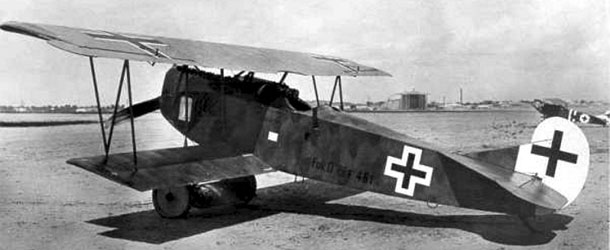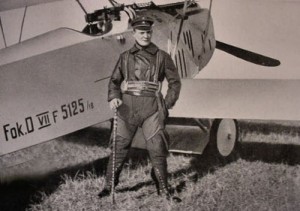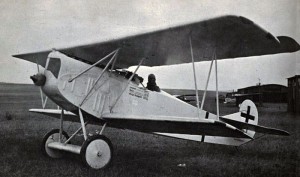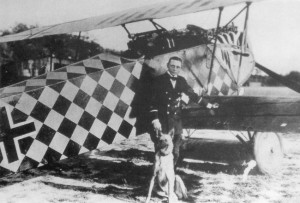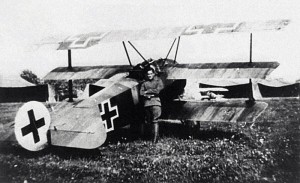In the previous article, we presented the Fokker D.VII fighter. Now, it’s time to take a look at the pilots who flew the versions of this fighter featured in the Wings of Glory Airplane Packs: Oberleutnant Hermann Göring (JG1, Luftstreitskräfte), Leutnant zur See Gotthard Sachsenberg (Jagdgruppe Flandern Marine Fliegertruppe), and Leutnant Rudolf Stark (Jagdstaffel 35b, Luftstreitkräfte).
Hermann Göring
Later known for his role as a leading member of the Nazi Party and second most powerful man in the Third Reich, during World War 1 Hermann Göring, or Goering, was an ace German pilot. He scored 22 victories, four while flying the Fokker D.VII, including the last one with the aircraft featured in the WW1 Wings of Glory Airplane Pack.
Born in January 1893, in Bavaria, German, Göring first served in an infantry regiment in the Prussian army and was commissioned in June 1912. In 1915, while away from the front and recovering from rheumatoid arthritis, he was convinced to transfer to the air force by his friend Bruno Loerzer. His request was turned down, but he transferred any way, and flew as Loerzer’s observer later that year, risking the consequences. Pardoned after a military court sentenced him to three weeks’ confinement to barracks, Göring was assigned to Feldflieger Abteilung 25 (FFA 25). Together with Loerzer, they won the Iron Cross, First Class, for their reconnaissance work.
Göring scored his first victory as a pilot on 16 November 1915, when he shot down a Farman over Tahure. He downed another two enemies in February and July 1916, at FFA 25, before being transferred to Jagdstaffel 26, commanded by Loerzer, in February. That same month he was separated from his flight, but still went after a twin-engine biplane. After he knocked out one of its engines, a flight of Spads appeared and immediately attacked. He fought them for fifteen minutes, as he flew all-out for the German lines, but the Spads hit him and his aircraft. He managed to land near a field hospital and returned to action after a couple of months.
In June 1917, after scoring 8 victories, Göring was given command of Jagdstaffel 27, a unit made of new graduates from flying school. In this squadron he achieved more victories, reaching 21 after one year.
On July 1918, he assumed command of Manfred von Richthofen's JG I. Many aces of the group (some with more than 40 kills) were annoyed with his nomination, but he turned out to be a good group leader, even if he was not popular with the men because of his arrogance. His final victory was scored with a Fokker D.VII on 18 July 1918.
By the end of the war, Göring was repeatedly ordered to withdraw his squadron, first to Tellancourt airdrome, then to Darmstadt. At one point he was ordered to surrender the aircraft to the Allies, but he refused. Many of his pilots intentionally crash-landed their planes to keep them from falling into enemy hands.
Like many other German veterans, Göring believed the German Army had not really lost the war, but was betrayed by the civilian leadership: Marxists, Jews, and especially the Republicans, who had overthrown the German monarchy. In the 1920's he met Adolf Hitler and became a leader of the Nazi Party in the 1930's.
He founded the Gestapo in 1933, and in 1935 was appointed commander-in-chief of the Luftwaffe, a position he held until the final days of World War II. By 1940 he was at the peak of his power and influence; as minister in charge of the Four Year Plan, he was responsible for much of the functioning of the German economy in the build-up to World War II. Adolf Hitler promoted him to the rank of Reichsmarschall, senior to all other Wehrmacht commanders, and in 1941 Hitler designated him as his successor and deputy in all his offices.
After World War II, Göring was convicted of war crimes and crimes against humanity at the Nuremberg Trials; he was the highest-ranking Nazi to be tried there. Sentenced to death by hanging, he committed suicide by ingesting cyanide the night before the sentence was to be carried out.
Gotthard Sachsenberg
A fighter ace with 31 victories, Gotthard Sachsenberg commanded the world's first naval air wing – the Marine Feld Jagstaffel, in February 1917.
Born in December 1891, at Dessau, Anhalt, Sachsenberg entered service as a sea cadet in April 1913, and was promoted to officer in 1914. He received the Iron Cross, First Class, for excellence as an artillery spotter in August 1915, and the following month he was commissioned as a Leutnant. He transferred to the air service in December that year, and was assigned to Marine Feldflieger Abteilung 2 in the role of Fähnrich zur See observer. In 1916, he became a pilot, after training at Johannisthal, and went back to MFA2, flying a Fokker Eindekker.
Sachsenberg assumed command of Marine Field Jasta I in February 1917, and also led the Marine Jagdgruppe Fianders, a larger unit formed by MJF 1 and MJF II. His first victory as fighter pilot was achieved on 1 May 1917, when he downed a Belgian Farman and a Sopwith 1½ Strutter. He ended the year with 8 wins scored, and continue to increase the count in 1918.
On 5 August 1918, Sachsenberg was awarded Prussia's and Germany's highest decoration, the Pour le Mérite. On 12 August he scored his 20th and 21st victories. It was a special day for him and to his unit, which totaled 7 victories. Most of the combat in which he engaged was against Royal Naval Air Service aircraft. His final victory was on 29 October, when he downed his 31st enemy.
Naval units started flying Fokker D.VIIs in June 1918. As with Richthofen’s Flying Circus, they distinctly painted their Fokkers with a yellow and black color scheme. Sachsenberg's own aircraft was painted with yellow and black checkerboard. In October 1918, Marine Jagdgruppe Fiander comprised five naval Jastas, with more than 50 fighter planes.
Post-war, Sachsenberg formed a squadron providing aerial support to the Freikorps. The unit fought Russian communist forces and established air superiority over their opponent, mainly flying ground support missions on behalf of the Freikorps. After the Baltic War ended, Sachsenberg initially concerned himself with helping his fellow veterans make the transition back to civilian life.
Later, he found Aero Lloyd Airlines and in 1932 he became an anti-Nazi member of the German parliament, taking a pacifist stance. Even with Nazi power rising, he escaped conviction because his family shipyard was producing military ships. After the war, he dedicated his efforts to designing hydrofoil ships, along with pioneer Hans von Schertel. Sachsenberg died in Bremen of a heart attack on 23 August 1961.
Rudolf Stark
Born in February 1897, the ace Rudolf Stark started his military career in World War 1 serving the 2nd Royal Bavarian Uhlans King, winning Bavaria's Military Merit Order on 29 September 1915, and the Iron Cross, Second Class, on 11 June 1916. He transferred to the German Air Force and was assigned to the FAA 296 reconnaissance unit in November 1917, as a 2-seater pilot.
Soon, he requested a transfer to a fighter squadron and, after training at Jastaschule II, joined Jasta 34b, in early 1918. In this unit, he scored his first win on 23 March 1918, and 5 more victories (one of them not confirmed), by 19 May. Five days after he joined Jasta 77b as acting commander, he scored his sixth confirmed victory. Only one of three victory claims was approved while he led Jasta 77.
On 7 June he was reassigned to Jasta 35b as commanding officer, and in this unit he first flew the Fokker Dr.I, scoring five more victories. The Dr.I he used was designated by a lilac engine cowling and lilac band around its fuselage. In August 1918, the unit received its first Fokker D.VII, with others following, but there were not enough D.VII for everyone. Stark also painted his D.VII in lilac as a continuation of the color he had used before.
Stark was wounded in action on 16 September, but continued flying right up to his final victory, two days before the Armistice. On 9 November 1918, he downed a S.E.5a. He ended the war credited with eleven confirmed and five unconfirmed aerial victories. In WW2, he joined the Luftwaffe and commanded a fighter base in Sicily. In 1933, Stark wrote the book "Wings of War: An Airman's Diary of the Last Year of World War One," detailing his experiences as a fighter pilot in the Imperial German Air Service in the last year of the war.
Information sources: The Aerodrome (Göring, Sachsenberg, Stark), Wikipedia, First World War, Belgian Wings - Varsenare/Jabbeke, "Fokker D VII Aces of World War 1, Part 2" (Norman Franks, Greg Van Wyngarden, Osprey Publishing, 2004).

